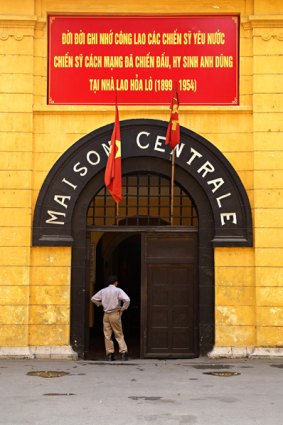
Hao Lo Prison, known to Westerners as the Hanoi Hilton.Credit: AFP
Australia's involvement in the Vietnam War lasted more than 10 years, but its effect continues to be felt more than 35 years later. An increasing number of Australians are drawn to Vietnam by its history, some curious to see the impact of war; others to make peace with their past. Visiting the battlefields, museums and memorials is challenging but if you cut through the propaganda and are willing to leave your Hollywood interpretations of the war behind, there's a chance to gain a valuable insight into the tragedy that took place here for both sides.
Ho Chi Minh's mausoleum
Villain to the West and hero to the Vietnamese, Ho Chi Minh remains a contentious historical figure. He led the North Vietnamese military campaign first against the French, then against the US, until his death in 1969.
His body now lies in state, against his wishes, and it's clear why officials ignored his request to have his ashes scattered across the country: he continues to have a unifying effect on his people. Thousands make the pilgrimage daily to pay their respects to "Uncle Ho". Visiting Ho Chi Minh's mausoleum in Hanoi is an assault on the senses. You're blasted with ice-cold air-conditioning, your eyes take a while to adjust to the dim lighting and there is no sound as the crowds file around his embalmed body.
5 Pho Ngoc Ha, Hanoi. Closed on Mondays.
Hoa Lo Prison
Better known as the Hanoi Hilton, where US prisoners of war were held, Hoa Lo Prison was built by the French in 1896. Recently renovated, most displays emphasise the mistreatment and torture of prisoners by the French while at the same time maintaining that US POWs were treated well.
The museum has two small rooms dedicated to US POWs. Pride of the collection is the flight suit worn by former prisoner and last year's Republican presidential candidate John McCain, alongside images of him being pulled from his downed aircraft. Smaller artefacts, such as a written request for one POW to take his pet cat home with him on release from the prison, add another layer of meaning to a complicated war.
1 Hoa Lo, Hanoi. Closed Mondays.
DMZ
The demilitarised zone, or DMZ, refers to the area around the Ben Hai River, which separated North and South Vietnam, where a number of high-profile battles took place. Tours depart from Hue and take in a section of the Ho Chi Minh Trail, Ben Hai River, a burnt-out church pock-marked with bullet holes, Vinh Moc tunnels and Khe Sanh Combat Base, where a small museum has been built.
The landscape surrounding the DMZ is barren and broken. There isn't much to see because most of the significant landmarks have been destroyed or scavenged for scrap metal, and the land has been scorched permanently by the chemical defoliant known as Agent Orange. What makes this trip worthwhile is it gives you a sense of the sheer physical devastation of this land. There is something humbling about standing in a bomb crater carved metres into the ground.
Tours depart daily from Hue and cost about $US20 ($24) for a full day, including lunch. Annan Tours, phone + 84 90 514 0600.
War Remnants Museum
Formerly known as the Museum of American War Crimes, this museum is one of the world's most confronting. Graphic images itemise, in detail, atrocities committed during the Vietnam War, including the ghoulish display of deformed foetuses to show the ongoing effects of Agent Orange on the Vietnamese.
Although the museum is high-voltage propaganda at best, it offers an uncensored glimpse into the brutal reality of war.
A number of small displays are worth sticking it out for, including a moving exhibit of work by foreign correspondents and photojournalists killed in Vietnam. Be sure to look carefully at the collection of medals donated to the museum by US veterans, including a Purple Heart engraved with the quote: "I was wrong".
28 Vo Van Tan, Ho Chi Minh City.
Cu Chi tunnels
Bent over double and deprived of oxygen in the cramped underground tunnels once used by the Vietcong, it's hard for your body and mind not to cave in to overwhelming claustrophobia and panic. I lasted just minutes before I had to be brought up to the surface by the guide, making it hard to imagine how the Vietcong survived underground for months.
The infamous Cu Chi tunnel system was a 250-kilometre network that helped the Vietcong infiltrate an area just 40 kilometres from Saigon (Ho Chi Minh City) during the 1960s, and eventually win the war.
Two sets of tunnels exist. There's the re-creation better suited to Western waistlines, at Ben Duoc, and the real thing at the village of Ben Dinh.
Both tunnels are at Cu Chi and are accessible from Ho Chi Minh City. See cuchitunnel.org.vn.
Long Tan memorial
The Long Tan memorial has become an important pilgrimage spot for Australians visiting Vietnam. The Battle of Long Tan was one of Australia's gutsiest military clashes, where about 100 Australian soldiers held back a Vietcong force of 1500-plus troops. Tragically, 18 Australian diggers died.
Access to the battlefield and official memorial, re-established on the site south of Saigon in 2002, is restricted and visitors must apply for a permit.
Details about visiting the memorial is available from the website of the Australian embassy, vietnam.embassy.gov.au/hnoi/consular07.html.
Sign up for the Traveller Deals newsletter
Get exclusive travel deals delivered straight to your inbox. Sign up now.